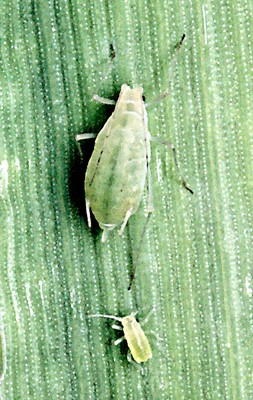Pests
Metopolophium dirhodum Walk. - Rose-grain Aphid
Systematic position.
Class Insecta, order Homoptera, suborder Aphidinea, superfamily Aphidoidea, family Aphididae, subfamily Aphidinae, tribe Macrosiphini, subtribe Macrosiphina, genus Metopolophium.Biological group.
Oligophagous pest of cereals.Morphology and biology.
Ovoid body of apterous female is light green; length about 2.2-2.8 mm, with double dark green oblong stripe on notum. Antenna is 6-segmented, light, slightly shorter than body length. Antennal tubercles are low; frontal flute is wide (its depth is 1/4 the distance between antennal bases). Distinct tubercle is located in the middle of frons. The insect has light cylindrical siphunculi (1/6 the body length) with a small widening near base. Conic light green tail is about 1/2 length of siphunculi. Legs are light but tibial apices and tarsi are dark. The winged female has ovoid light green body, about 1.7-2.3 mm in length. Antenna is dark, longer than that in apterous female. Oval eggs are black. Overwintering takes place at the phase of egg. Eggs are located at bud base or on its surface, on young shoots of Rosaceae plants. In the zone of strong harmfulness, hatching of fundatrix larvae is observed in March - beginning of April. Insects prefer lower side of upper leaves on rose and dog-rose. They also feed on flower buds and flower stalks. Aphids suck sap from leaf veins. The species is facultative migrant, its second hosts are wheat, barley, oat, and other plant species of families Poaceae, Cyperaceae, Juncaceae. Most part of migrants is marked in May - beginning of June; maximal insect number is in the middle and end of June. In July the insect number considerably decreases because of tissue hardening and entomophage activity. Aphids feed on lower side of leaves along veins. They live openly, do not form big colonies. Non-migrating part of the population continues development on rose and dog-rose. Larval period lasts 7-11 days; life span of apterous females is about 20-38 days (depending on generation, plant-host, climatic conditions). Their fecundity reaches 160 larvae. In August the migration to primary host takes place. Viginoparae appear in August - October, giving sexual generation. In October the females lay eggs by 3-5 near bud bases. The oviposition lasts until strong frosts and leaf falling.Distribution.
The species is spread in Europe; Anterior and Middle Asia; North America. Within the territory of the Former USSR, it lives widely in the zone of growing of hosts, such as wheat, barley, oat, cereal grasses, also rose and dog-rose. Its low harming activity is reported in steppe zones of Ukraine, Lower Volga Basin Region, North Caucasus, Transcaucasia, Middle Asia, South Kazakhstan. Higher harming activity is not reported within the territory of the Former USSR.Ecology.
Hatching of fundatrix larvae is observed at daily temperatures 12-14°C and at lower developmental threshold 5-6°C. The most favorable conditions for apterous female are the temperature 21-25°C and relative humidity 70-80%. In autumn viginoparae appear at the temperature 14-16°C and short light day. The pest gives 10-14 generations during a year. Most important predators are Adalia bipunctata L., Propylaea 14-punctata L., Coccinella septempunctata L., C. quinquepunctata L., Adonia variegata Goeze., Chrysopa perla L., Ch. carnea Steph., Ch. albolineata Kill., Ch. vulgaris Schn., Syrphus corollae F., S. balteatus Deg., S. ribesii L., S. interrumpes Walk., Paragus aegiptius Wd., Ephedrus persicae Frogg., E. plagiator N., E. cerasicola Stary, Praon volucre Hal., Praon volucre Hal., Aphidencyrtus aphidivorus Mayr.Economic significance.
The species is oligophagous. It damages wheat, oat, barley; feeds also on cereal grasses. Damaged leaves become yellow, twisted, and then dry up. Plants lag in growth. High harming activity within the territory of the Former USSR is not reported. Control measures include due forecasting the pest appearance and numbers, eradication of weeds, insecticide treatments in May - June.Reference citations:
Cannon R.J.C. 1985. Colony development and alate production in Metopolophium dirhodum (Walker) (Hemiptera: Aphididae) on winter wheat. Bulletin of Entomological Research 75(2): 353-365.Cochrane J. 1980. Meteorological aspects of the numbers and distribution of the rose-grain aphid, Metopolophium dirhodum (Wlk.), over south-east England in July 1979. Plant Pathology 29(1): 1-8.
Hill A.R. 1971. The reproductive behaviour of Metopolophium festucae (Theobald) at different temperatures and on different host plants. Annals of Applied biology 67 (3): 289-295.
Ivanovskaya O.I. 1976. Fauna of aphids on the territory of West Siberia. In: Zolotorenko G.S., ed. Fauna of helminthes and arthropods of Siberia. Novosibirsk: Nauka. P. 175-189 (in Russian).
Johnston R.L. & Bishop G.W. 1987. Economic injury levels and economic thresholds for cereal aphids (Homoptera: Aphididae) on spring-planted wheat. Journal of Economic Entomology 80(2): 478-482.
Mordvilko A.K. 1921. Cereal aphids (Aphidoidea). Part 1. Petrograd: State publishing house. P. 43 (in Russian).
Nevskii V.P. 1929. Aphids of Middle Asia. Proceedings of Uzbekistan Experimental plant protection station 16. Tashkent. 82-83 p. (in Russian).
Pashchenko N.F. 1979. Aphids (Aphidinea), damaging cereals in Primiorskii territory. In: Ivliev L.A., ed. Ecology and biology of arthropods in southern part of Primorskii territory. Vladivostok: AN USSR. P. 57 (in Russian).
Shaposhnikov G.Kh. 1964. Order Homoptera - homopterous. In: Kryzhanovskii O.L., ed. Insects and mites - pests of agricultural crops. V. 1. Leningrad: Nauka. P. 602 (in Russian).
Weber G. 1985. On the Ecological Genetics of Metopolophium dirhodum (Walker) (Homoptera, Aphididae). Zeitschrift fur angewandte Entomologie 100(5): 451-458.


